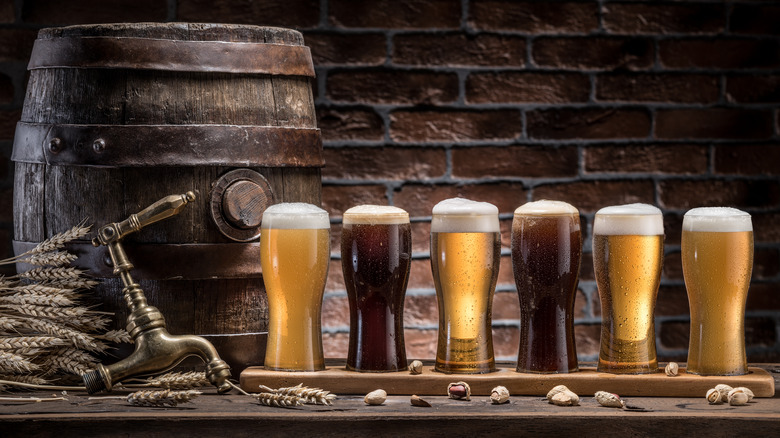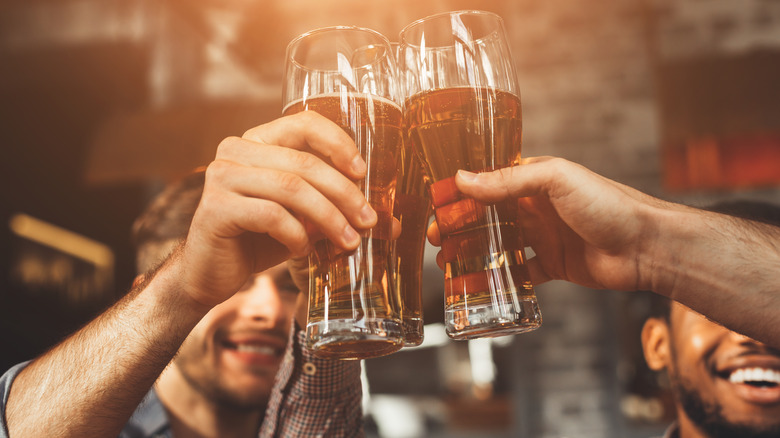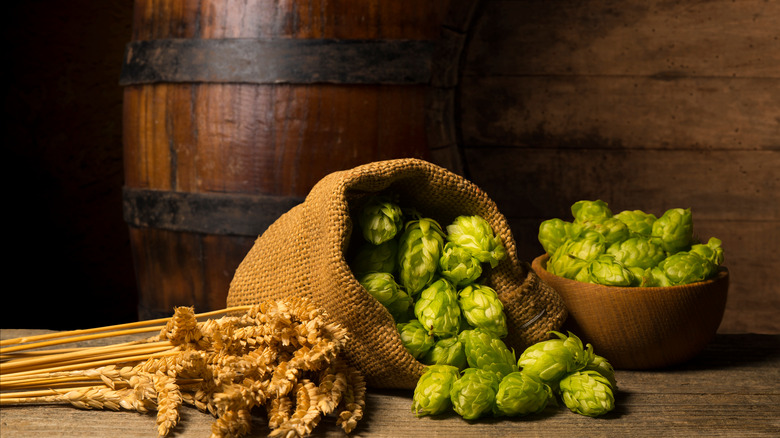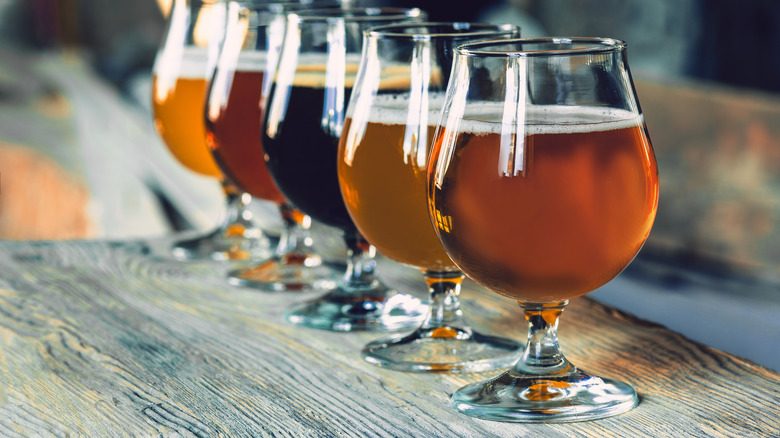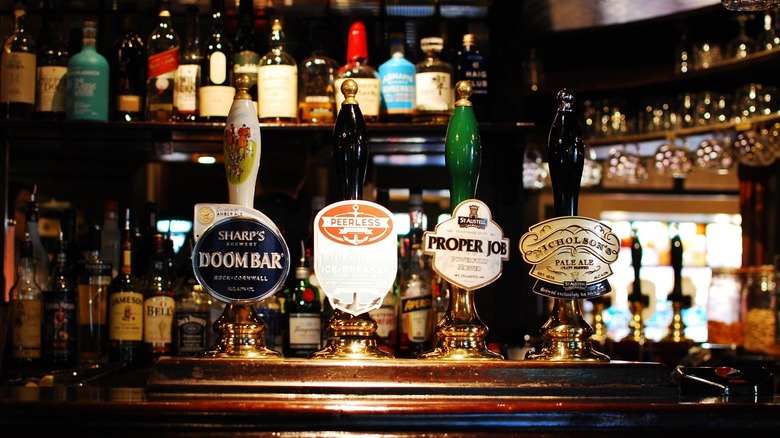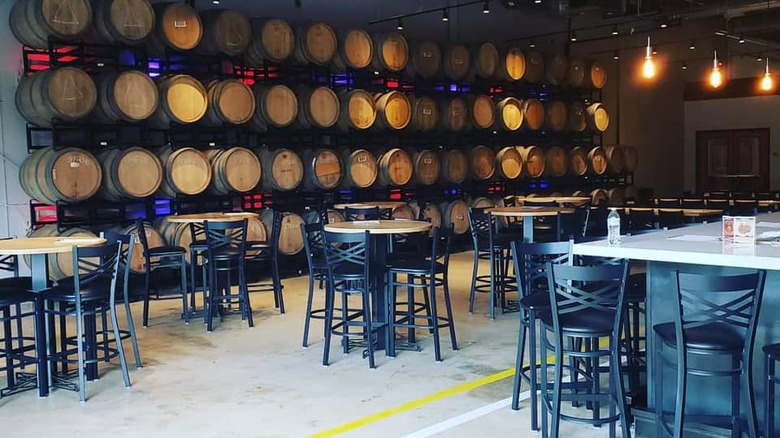Everything You Need To Know About Cask Ale
Cask ale, or cask-conditioned beer as it is also known, refers to beer in which brewer's yeast is added for a slight secondary fermentation as it matures (or conditions) in cask, providing a natural carbonation. Traditional cask ale, as Renegade Brewing notes, is unfiltered and unpasteurized, and is served directly from the cask by means of a beer engine, or hand pump.
Because it is made naturally — indeed, with no preservatives or chemical intervention at all — cask ale is far more perishable (per the Brewers Association) than modern-style beers, which are pasteurized or cold filtered. Ideally, cask ale should be consumed within five to seven days of tapping, and it is a beer best served at cellar temperature, around 55 degrees Fahrenheit.
As CraftBeer.com explains, "the net result is a beer that has a much gentler level of carbonation, a rounder mouthfeel, and since it is unfiltered, usually shows a slightly more complex flavor and aromatic profile."
The history of cask ale
Cask ale is one of the oldest extant beer styles, with a history that dates to the Middle Ages in England. As Judith M. Bennett notes in her book "Ale, Beer, and Brewsters in England," before the arrival of the bubonic plague in the middle of the 14th century, cask ale was primarily brewed and sold by women. That changed afterwards due to a number of factors, but cask ale remained synonymous with British pub culture until the modern era, when the invention of pasteurization in 1864 made beer easier to preserve, and the introduction of vacuum-sealed metal kegs (via Pilsner Urquell) in the 1950s — first aluminum, and later stainless steel — made it easier to store and serve.
But as beer modernized, cask ale proponents arose to preserve this traditional beer style. CAMRA, the Campaign for Real Ale, was founded in the UK in 1971, and has led the charge to save what it calls "live beer," a term the consumer organization uses to refer to a "whole family of beers that adopt the principle of continuing to condition in their final container, an important factor in maximising the flavour of a beer."
The language of cask ale
One of the joys of cask ale is that it reintroduces an old-school vocabulary into beer drinking: that of the cask and all its accouterments. The firkin, which holds nine gallons and pours 72 pints (per Joseph Holt Brewery), is by far the most popular cask size, but others commonly used include the pin (4.5 gallons) and kilderkin (18 gallons). Casks are placed on what is called a stillage to settle all the sediment before pouring commences.
According to the Brewing Industry Guide, each cask has two holes in it, one near the head is sealed by a keystone; the second larger hole, the bunghole, is sealed by a shive. The former is where the tap is placed, the latter is used for venting before the beer is served. Of course, there is also the vocabulary of fermenting beer, from wort to sparging, before it is racked into casks to condition, a process detailed by Cask Marque.
What makes cask ale different from keg beer
The most common criticism leveled at cask beers is that they are warm and flat. It is true that they are unable to compete in these areas when compared with keg beers, which are typically cold filtered, refrigerated, and force carbonated with CO2. American palates, untutored in traditional British pub culture, have helped to foster this stereotype, and as Beervana Blog notes, some craft breweries haven't always served cask ale properly.
But when served at the proper temperature to showcase its natural carbonation, cask ale isn't warm and flat at all. Rather, because it is unfiltered and unpasteurized — a live beer — it is capable of stunning complexity and flavor, and (per CraftBeer.com) represents draught beer at its finest.
Thus, even as the British Beer and Pub Association reports that sales of cask beer have plummeted during the pandemic, there remains an ardent core of traditionalists, from CAMRA to artisanal brewers, who love and continue to champion cask-conditioned beer in both the UK and the U.S.
Tasting tips for cask ale
Like most wines, cask ale is best enjoyed at "cellar temperature," between 50 and 55 degrees Fahrenheit. If served too cold, Cask Marque notes, it loses flavor. Serve it too warm and it develops some flavors you don't want. The organization recommends using a half-empty glass when tasting, which allows one to swirl and then take a quick inhale to enjoy the complex aromatics. Just as wine tasters may be familiar with the wine aroma wheel, CAMRA makes a similar wheel for cask ale drinkers, allowing them to pick out aromas that suggest the beer has faults or flaws, or may just be flat-out bad.
When taking the first sip, Cask Marque says, one should taste the sweetness from the malts at the front of the mouth, with the dry and bitter flavors dominating at the back of the mouth before what is hopefully a memorable finish. With experience, cask ale enthusiasts should be able to distinguish between the aroma and flavor profiles of various beer styles. Born in British pub culture, Joseph Holt Brewery observes that cask ale is made in all the traditional British styles, from mild and bitter ales to golden ales, pales ales, IPAs, and stouts.
Where to find cask ale in the U.S.
Cask ale is not widely available in the U.S., per Punch Drink. Rather, it is something one must seek out. That's part of its charm. But there are breweries or taprooms that sell cask ale in virtually every region of the country, from Fortnight Brewery in Cary, North Carolina, which produces beers in casks as well as cans, to Machine House Brewery in Seattle, Washington, which has been producing cask-conditioned ales since 2013.
The Western U.S. is home to many of the best cask ale providers: Yorkshire Square Brewery in Torrance and Macleod Ale Brewing Company in Van Nuys, California; The 3 Legged Crane Pub and Brewhouse in Oakridge, Oregon; Machine House Brewery in Seattle; and Hogshead Brewery in Denver, Colorado. The Midwest has a few cask ale traditionalists as well, including Union Brewing Company in Carmel, Indiana, and Laxton Hollow Brewing Works in Lexington, Ohio. Seneca Lake Brewing in Dundee, New York, represents real ale on the East Coast. To find more, including the cask ale provider nearest you, contact the Brewers Association.
